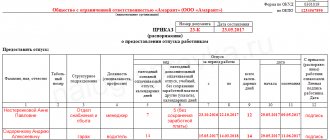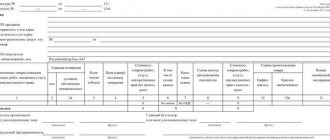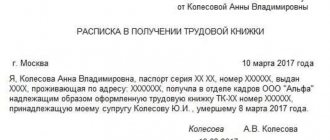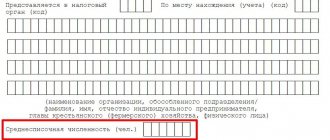What is provided and why is it needed
The organization that maintains the personal files of employees, for the convenience of recording them, opens an appropriate journal.
This document is not provided for by any current regulatory act at the level of federal or even regional legislation, therefore the employer develops its form independently and approves it with his order or directive. The journal as such simplifies working with employees’ personal data, which is organized into subfolders:
- all information is systematized;
- finding it takes little time;
- convenient to use;
- an optimal level of protection of personal data from third parties is ensured;
- after all, it looks aesthetically pleasing.
As we have already said, this procedure for storing personal data is mainly used in the civil service, where it is mandatory. Therefore, the approach there is quite serious:
- documents for dismissed and current employees are stored separately from each other;
- As a rule, the storage of these documents is a separate room or isolated room;
- all papers and folders are placed in metal cabinets to prevent access by third parties;
- Only selected - specially appointed employees - have access to the premises or storage facility.
That's not all. To get acquainted with the contents of his file, and a civil servant is obliged to get acquainted with its contents at least once a year, a separate place is allocated; as a rule, it is located in a storage facility, but, depending on the footage and the capabilities of the organization, a separate room may be allocated.
This, as has already been said, for state companies and for all other organizations, the rules and storage procedure are established by the company’s management, but with one ironclad requirement prescribed by law - the personal data of employees must be protected, and no one is allowed to violate the confidentiality regime.
The journal of personal files of employees, a sample of which we have provided below, is used, as a rule, to record the fact that personal information from a particular case has been reviewed by a specific person and for a specific purpose. In general, for this purpose they use a familiarization card, which is actually stored, but the journal is more convenient to use for inspectors: you can immediately see how work is being done in this area of personnel records in the organization.
Registration of a personal file
Watch a short video on how to register an employee’s personal file and everything will become clear:
Before we talk about managing personal affairs, let’s take a closer look at how to formalize them correctly. The formation of a case begins from the date a person is hired and continues until the moment of his dismissal. For each task, it is better to take a separate folder, or at least a file.
When an HR employee creates a personal file, he must remember that:
- It is better to replace original documents with photocopies, in order to avoid a situation where the original of an important document is lost (there are often cases when original diplomas are lost, and it is not easy to restore them);
- One copy of each document is included in the file;
- Documentation of temporary storage and permanent storage are not stored together;
- It is better that one case does not exceed 4 cm in thickness;
- It is better to keep applications in the same place as documentation.
All personal files should be prepared in the same way, and a log of personal files should be kept in order to avoid the loss of important documentation.
So, a sample of a personal file:
- The cover of the personal file contains the surname and initials of the employee, the date when the case was started;
- If there are no separate folders for storing things, then it is better to place them in one folder in alphabetical order;
- The number of pages should not exceed 250;
- Each folder is marked with a case number.
Why is it needed and what is it provided for?
Any institution that manages the personal affairs of employees can, for the convenience of document recording, draw up a logbook. It will make working with the personal data of the organization’s employees easier, because:
- all information is systematized;
- searching for information takes less time;
- this format is easy to use;
- The protection of personal data of employees is at the required level.
Basically, personal data of employees using fixation is used in the civil service, and the requirements for data storage are strict:
- documents on dismissed civil servants and employed ones are stored separately;
- storage location - separate room;
- papers should be placed in metal cabinets;
- access by third parties is excluded;
- Only specially authorized employees can enter the office.
The procedure for recording and storing personal files of civil servants is strictly regulated by Federal Law No. 79-FZ dated July 27, 2004 “On the State Civil Service of the Russian Federation” and Decree of the President of the Russian Federation dated May 30, 2005 No. 609 regarding personal data of civil servants.
The accounting book allows you to establish the actual familiarization of the civil servant with the case materials, as well as their purpose. Despite the fact that personal files contain an introduction card, keeping a journal of personal files allows you to optimize the process, including for inspection authorities.
Do I need to keep records?
The legislator has provided for the obligation to register a personal file for each employee exclusively for employers classified as state or municipal.
For employees employed in the civil service, regulations establish a list of documentation contained in the dossier, as well as the methods and conditions for its storage.
Due to the convenience of collecting information about employees by maintaining a personal file for each employee, such documents are also used in private sector enterprises (organizations).
The register of workers' affairs is included in the nomenclature of state structures without fail, since in these institutions the dossier is a mandatory element of office work.
Private companies have the right to create a file on their workers, and for the purpose of making it easier to find the necessary information and record basic information about their personal files, keep logs of their records.
The legislator also establishes the requirement that the person responsible for preparing and maintaining a personal file undertakes to familiarize the employee in respect of whom it is being maintained with the list of documentation and general information contained in the file.
Logbook form
The form can be developed by HR department specialists and approved by the employer’s local administrative act.
Before making the logbook, you need to determine how the pages will be arranged - vertically or horizontally. The first option is optimal for a small number of graphs. If it is necessary to reflect a large amount of information, the second option is acceptable.
It is better to make the cover from thick A4 paper, indicating on it the name of the institution, information about the beginning of the management and its end.
Information about the employee responsible for maintaining the document can be reflected on the cover (on either side) or on each page. Information can also be placed on the last page.
The form for presenting information may be as follows:
The pages of the personal records book must be protected from seizure and additional investments. To do this, you can use the following options:
- The pages are numbered, laced, sealed with a seal (waxing wax, mastic), the accounting journal itself is certified by the head of the personnel service or the deputy head of the institution in charge of personnel issues, or directly by the head.
- The sheets must be numbered in order and laced together. Place a sticker on the lacing knot on the last page with the imprint of the seal of the personnel service or organization. Make a certification:
Entries must be made in blue, purple or black ink. Corrections or deletions of information using corrective means are not permitted.
If it is necessary to make corrections, erroneous entries must be crossed out with one line so that the previously entered information is clearly readable. A new entry should be made in the same column. If there is a “Note” column, an entry is made in it.
If there is no such column, erroneous data is not crossed out: under it you should make an o and enter the current information.
What should be in an employee's personal file
The composition of a personal file is not regulated at the level of regulations. It is strictly approved only for the state. employees. Any organization can use the approved list and decide which documentation to include in the files of its employees and which not.
The list is:
- Photocopy of passport (most often the first page, marital status and place of registration);
- A photocopy of a diploma, advanced training document, etc.;
- Photocopy of SNILS;
- If the employee is liable for military service - a copy of the document confirming this;
- Photocopy of TIN;
- Documentation of passing a professional examination and medical examination (if this is provided for by the company’s activities);
- A certificate stating whether the citizen has a criminal record or lack thereof (if provided for by law);
- A job application written by the employee personally;
- Autobiography;
- A copy of the employment contract;
- A photocopy of the work record;
- Materials about certification (if carried out);
- Employee photographs that are periodically updated;
- Description of personal file.
This list may change and be supplemented, depending on what activities the company conducts and what personnel policy it implements.
In addition, all documents must be placed in the file in chronological order: the very first ones that were included when the person was hired, then those that appeared during his activity.
It is prohibited by law to include in the file information about the personal life of an employee, about his views on politics and religion, if he did not give written consent to this.
Personal file: what does it include?
A personal file is a folder in which various papers relating to an employee of an enterprise are filed. These documents can be either originals or copies. There is a list of documents that are filed in such a folder:
- an employee’s application to this organization for employment;
- the employment contract that was drawn up when this person joined this organization; in addition, all additional agreements that were concluded in addition to the employment contract itself;
The last paragraph indicates that the list is not exhaustive; if necessary, other papers not mentioned above can be added to it.
In addition, the personal file must contain an inventory that includes a list of all documents that are present in it.
For each of the papers included in the personal file, it must contain the following information:
- the name of the document itself;
- the day this paper was filed in the folder;
- the number of sheets contained in this document;
- if a document is seized, then in the place of the inventory where it is discussed, a mention of the fact of seizure is added, the reason for it and the person who did it are explained, and the date is also set.
An authorized employee certifies this inventory.
The procedure for filling out a personal file folder
The entire folder, including the cover, must be filled out properly, as specified by law and prescribed by the internal rules of the organization for the personnel department.
Title page
The title page is filled out in accordance with GOST requirements:
- It is necessary to leave space for a stamp at the top of the document so that archivists can make a note;
- A little lower you should indicate the full name and details of the organization;
- Under this entry, also in the center, you must indicate information about the department; this entry must have several empty lines so that the entry can be adjusted in case of employee transfer;
- Next, indicate the case number with an index designation, for example, “Case No. 07 – 369”;
- Next comes the name of the folder - the employee’s full name;
- In the lower right corner, you must indicate the dates of opening and closing the case, as well as the storage period; after the inventory, you must indicate the number of sheets in the document.
Paperwork
All matters relating to the management of a personal file must be handled by an authorized employee of the HR department. Important: he is responsible for the safety of confidential information.
Regarding the preparation of documents, he is obliged to:
- Accept;
- Number;
- describe;
- Hem;
- Make changes if necessary;
- Close the case;
- Archive.
He is also obliged to familiarize the employee with his personal file against signature; this procedure must be performed at least once a year, this is necessary to maintain the relevance of the information.
To do this, it is necessary to create a statement in which the employee will annually sign that he has read the documentation.
Important: personal files are handed over to law enforcement and regulatory authorities upon request.
Internal inventory
The internal inventory of documents is compiled in accordance with the unified form Appendix 10.
It includes:
- Document registration number;
- Assigned index;
- Date the document was recorded;
- Title;
- Sheet numbers according to case numbering;
- Note.
In the folder, such a sheet is indicated on the back of the title or filed last to the general documentation. The register is signed by its compiler with a transcript of the signature and an indication of the date. If it consists of several sheets, their numbering is necessary.
Document storage requirements
The personal files of all employees who currently work at the enterprise must be kept in its personnel department, accordingly, the journal is kept there. A special fireproof cabinet is used to store them. The storage facility is kept locked and sealed.
The journal is available to the responsible employee of the HR department who maintains personal affairs and, in addition, to the head of the HR department. An authorized employee is appointed by the manager, who issues the corresponding order. Before starting work, he undergoes training. During this training, he is told about his responsibilities and the contents of the employee’s personal file, all the documents that need to be placed in it. Also, upon signature, he is introduced to the Regulations, which describe the processing of the employee’s personal data, and also contain the rules for their protection, as well as the rules for maintaining a log of the employee’s personal affairs.
If such a need arises during the performance of duties, access to the personal files of employees is also provided to the heads of the structural divisions in which they are employed. A managerial employee of this level may have the opportunity to familiarize himself with data from the personal file of a subordinate; for this he needs to contact the head of the personnel department or the head of the enterprise. Upon receipt of permission, an order of appropriate content is issued. This document serves as the basis for admission.
You should disclose only the information and provide only those documents that are required by the head of the unit and that are expressly included in his request.
It is not allowed to give him access to other documents and, especially, to the entire personal file. Also, before providing him with information, it is necessary to familiarize the head of the department with the Regulations on Personal Data of Employees, which is adopted in this company, and obtain his signature that he is familiar with this document.
The employee himself has free access to his own business. He doesn’t need anyone’s sanction to get to know him. He can receive it against signature any day he needs it. Then he can study it until the end of the working day, after which he needs to return the file to its storage location.
When an employee quits and moves to another company, it is possible to transfer the case to another company. This is carried out on the basis of a special request coming from her to the previous one, while such an obligation does not exist and the decision remains with the previous employer. When an employee retires, after some time his file is sent from the personnel department to the archive. The following periods are provided for its storage in the personnel service: three years in the general case and ten years if we are talking about civil servants.
Before sending the folder to the archive, it is stapled, assigned a number and a description is written.
The personal file compiled in this way is then sent to the archive, where it is kept for 75 years. Further, personal files are generally destroyed.
Special cases - folders with cases that relate to individuals who were leaders, received various knowledge and received state awards. Destruction is not allowed for their files; they are stored forever.
This video contains information about the personal affairs of employees.
The employee personal files log is an example of systematization of personnel appointment documentation. It is necessary to preserve the set of personal files of the organization’s employees and to implement the ability to quickly track information about the state of labor relations with a specific employee. The procedure for maintaining personal files by personnel services is mandatory for government agencies; other categories of legal entities are given the right to independently decide whether they need this type of personnel records or not.
Who should I register for?
It is mandatory to maintain personal files for those employed in the state civil service. This is required by Russian legislation. Entrepreneurs can regulate this issue by local regulations. This means that HR department employees can only open personal files for key employees.
This group includes:
- Management staff and their replacements;
- Chief specialists;
- Persons who are responsible for property and valuables;
- Employees with prospects for career advancement.
But still, it would be useful to create such dossiers for all employees, since they reflect information about employees that may be required at any time.
Personal records log - rules for registration and completion
The process of systematizing personal files in a journal can be carried out in several ways:
- Using serial numbering of cases.
- Using an alphabetical index.
- Broken down by structural divisions of the company or job categories.
Responsibility for filling out personal files and registering them rests with the personnel department or an authorized employee who has been assigned the appropriate responsibilities by order of the manager. The logbook for registering personal files of employees, a sample of which at enterprises may have individually designed forms, is signed by the responsible person after entering information into it.
All personal files opened at the institution must be recorded in the journal. Each column must be filled out. If necessary, the form of the form can be modified - add additional cells for data or remove unnecessary information. Corrections made are reflected in a special field - “Notes”. All entries must be numbered.
The employee personal affairs log, a sample of its design, must contain information about:
- the serial number of the record being made;
- number assigned to a specific personal file;
- date of establishment of the specified personal file;
- date of closure of the case;
- FULL NAME. employee;
- worker's personnel number;
- when the closing date of the case is indicated, the reason for this action must be indicated;
- locations of cases;
- date of submission of the case to the archive;
- field for comments.
It is proposed to enter all additional information about the employee in the notes column in the employees’ personal affairs log. It is allowed not only to purchase ready-made magazine forms, but also to create them on your own. To do this, you will need to create a title page with a tabular part of the journal for entering data about employees. After printing the required number of pages, they are stapled to the title page and numbered. Be sure to glue the ends of the lacing thread together and seal it with a seal; at the end, the person responsible for keeping the journal is indicated.
The title page must contain information about the name of the enterprise, the date of opening of the journal and the end of its maintenance. All entries in the journal columns are entered in chronological order. The color of the paste can be blue, black or purple. No blots or erasures should be allowed in the journal. All errors must be crossed out and placed in brackets, and the correct data must be written next to it. You should cross out so that you can make out which word was written earlier.
Employees' personal records log: sample
| Record number | Registration number of personal file | date of registration of personal file | FULL NAME. employee | Personnel Number | Case closing date | Reason for closing the case | Date of transfer of the case to the archive | Signature of the person responsible for the management of affairs |
| Ivanov I.I. | dismissal order dated August 17, 2017 No. 48-k | Sidorova |
Rules for filling out the journal
First of all, when preparing a personal records journal, the following information is entered:
- record number in order;
- personal file registration number;
- date of registration of the personal file;
- last name, first name and patronymic of the employee;
- Personnel Number;
- storage location for personal files;
- LD closing date;
- reason for closing the LD;
- date of archiving;
- notes.
[docs]
All this information must be written down in neat, legible handwriting; if possible, it is necessary to do without corrections in words, and also to avoid erasing. The ink color for filling out the title page can be black, blue or purple.
After this, the folder contains the actual documents. They are filed after the title page exactly in the sequence that corresponds to the time they were issued or provided by the employee.
The personal files of all employees are stitched together. They are also required to be recorded in a special journal, which is created for this purpose.
Is it obligatory for an LLC to keep a journal of personal affairs?
Having considered your question, we can say that labor legislation does not contain the employer’s obligation to keep logs of orders or personal files.
Consequently, the employer has the right to independently determine whether to keep personal records or not. There is no standard form for this magazine, so the organization’s personnel service has the right to develop it independently.
Details in the System materials:
- Answer: How to register documents received by the personnel service
Registration concept
Registration means that the document created, sent or received and data about it.
You will not have any questions about Hiring in an LLC after reading the article at the link.
The rules for registering and indexing documents are described in detail in the GSDO, approved.
Registration required
It is necessary to register documents in order to:
- ensure accounting of documents and control of their execution;
- facilitate the search for documents, create organizational search systems;
- ensure the safety of documents.
In addition, many types of documents created in an organization acquire legal force only after registration. For example, an order from the head of an organization begins to apply from the moment of registration. And the letter becomes official only after it is assigned an outgoing registration number.
Registration index
When documents are registered, they are indexed. That is, each document must be assigned a specific number and symbol (index). Indexes are necessary when searching, recording and systematizing documents. The registration index is not repeated during the year.
The registration index consists of:
- the serial number of the document within a certain array (for example, orders for main activities and for personnel, contracts, instructions, etc. are numbered separately);
- symbol of a structural unit (a structural unit can have either an alphabetic index - “k”, “ok”, “o/k”, or a digital index).
For example, an order for hiring an employee may have number 134-k, where 134 is the serial number of the document, and “k” is the designation of the structural unit.
In addition, the registration index often includes the case number. In a response to a letter, the index details are arranged in the reverse order: for example, in number 08-11/144, the first is the digital index of the structural unit - 08, then, separated by a hyphen, the case number according to the nomenclature - 11, from which the serial number of the document is separated by a slash - 144.
Such rules are established in the State Budgetary Educational Institution, approved by.
Registration form
You can register documents:
- in special registration journals;
- on cards (data about the document is recorded on a special card, which is then placed in a file cabinet).
Each of these registration methods has its own advantages. In the journal, all information about documents is compactly grouped, and the journal itself is conveniently stored in limited access. Therefore, documents that require particularly careful protection (for example, work books, contracts, invoices) are usually recorded in journals. Using cards, it is convenient to register documents that require execution and control - letters, orders, instructions. Cards can be reproduced and transferred to structural units. In addition, they are easy to systematize in any sequence and according to various criteria - by author, content, alphabet, etc.
Situation: What registration books and journals should be kept by the organization’s personnel service
The personnel service of the organization is obliged to maintain (Rules for maintaining and storing work books, approved). The forms of these books have been approved.
In addition, the HR department keeps logs:
- and so on.
We recommend reading about the Journal of Registration of Employment Contracts: questions and answers, material at this link.
There are no standard forms for these magazines, so the organization’s personnel service has the right to develop them independently.
A complete list of books and magazines maintained by the personnel service, as well as their storage periods, are indicated in the approved document.
Nina Kovyazina
Deputy Director of the Department of Education and Human Resources of the Russian Ministry of Health
How are personal files processed?
Personal files are formed and maintained, as a rule, by the personnel department. A personal file is created immediately after the registration of an employment relationship with an employee. To do this, purchase regular cardboard “Delo” folders or order special ones.
The title page of the personal file is the cover of the folder. For example, you can design the cover like this:
The start date of the personal file is the date of the hiring order, and the end date is the date of the dismissal order. The case number is initially established in the personal file register, where they are usually numbered in gross order or using indexes for different categories of workers. For ease of searching, the index and case number can be placed on the spine of the personal file folder.
Documents are placed or filed using a needle and thread in a folder in chronological order.
The personal files of employees are published in accordance with the Regulations. By virtue of GOST R 21.1101-2013, approved by Order of Rosstandart dated June 11, 2013 No. 156-st, stitching means the placement of project documentation materials on paper in bindings or in hard folders with easily removable fastenings (locks). We believe that the most convenient way to create documents for a personal file is to bind them into folders with detachable fastenings, rather than staple them.
In any case, pages must be numbered.
According to the Recommendations, it is unacceptable to create so-called personal file orders, when several personal files are stitched into one, thereby violating the general features of forming files and the procedure for working with restricted documents.
An internal inventory must be included in your personal file. Here is an example of a form:
| INTERNAL LIST OF DOCUMENTS units. hr. No.______________ No. | Document index | Document date | Document title | Case sheet numbers | Note |
| 1 | 2 | 3 | 4 | 5 | 6 |
Total ___________________________________ documents. (in numbers and words)
Number of internal inventory sheets __________________________. (in numbers and words)
Name of the position of the person who compiled the internal inventory of case documents
| Signature | Full name |
date
At the end of the case, a certification sheet is placed. It is compiled to take into account the number of sheets in the case and the peculiarities of their numbering. The certification sheet can be drawn up in the form established by the Basic Rules for the Operation of Archives of Organizations (approved by the Decision of the Board of Rosarkhiv dated 02/06/2002).
The certification sheet is drawn up on a separate sheet, which is placed behind the last document of the case. It can also be glued to the inside cover of a case.
Journal of registration and accounting of personal affairs
The personal affairs register allows you to register the personal affairs of employees.
According to Decree of the President of the Russian Federation dated May 30, 2006 No. 609, the obligation to maintain personal files of employees applies only to state and municipal authorities, however, many commercial organizations also work with personal files of employees, since this subsequently greatly simplifies the work: all information is systematized, and finding it takes a minimum of time.
View of the main section of the magazine:
How to register an employee’s personal file?
Registration of an employee’s personal file begins with correctly filling out the title page. This sheet indicates the last name, first name, patronymic of the employee, the start date of work in the organization (it coincides with the date of registration of the case) and the assigned number. Entries are made in neat handwriting, in blue, black or purple ink. It is advisable to avoid erasures and corrections when entering information.
Next comes in order all the available information on paper. The personal file is updated with documents as they are received during the period of work in the organization.
The personal file documents may include:
- employee's application for employment;
- employment contract and additional agreements to this contract;
- personal sheet for personnel records and additions to it;
- a questionnaire filled out by the employee himself or an autobiography written by him;
- a copy of education documents;
- extracts from orders confirming position;
- job description;
- characteristics of the employee, letters of recommendation, if any;
- photocopies of passport, marriage certificate, birth certificate of children, etc.;
- copies or extracts of personnel orders (transfer to any position, representations, etc.);
- documents on awards and incentives;
- information about violations, penalties;
- other documents related to a specific employee.
There must be an inventory in your personal file. This is a list of all the documentation filed in the personal file. It reflects the following information for each document:
- document's name;
- date of document filing;
- number of sheets of the entered document;
- when removing a document from a personal file, the date of withdrawal is noted, by whom and for what reason the ball was withdrawn;
- the completed inventory is certified by an authorized specialist.
The retention period for documents in the personnel service is: 10 years for civil servants and 3 years for all others.
When a file is transferred to the archive, it is stitched, numbered and described. A correctly completed personal file is transferred to the archive, where it is stored for 75 years.
After this period, the employees’ personal files are destroyed. The exception is documents of citizens who held leadership positions, had government awards and various titles, etc. Such files are stored permanently and cannot be destroyed.
Registration and further management of personal files of employees requires additional time and personnel resources. But a properly formed personal data base is a good assistant in the work of a personnel officer and company manager.
Control seal
The magazine is sealed with a numbered indicator holographic seal.
According to GOST 31282-2004, a control seal is a unique single-use indicator device designed to detect unauthorized access.
Before starting to work with the Journal, you must fill out the title page and certification. Be sure to enter the seal number in the appropriate line; without this, the Journal is not considered sealed.
Personal records book sample - Personnel management
Despite this, many enterprises have made it their responsibility for HR departments to maintain this document. Subsequently, this greatly simplifies the work, since all information is systematized and searching for it takes a minimum of time.
This is a folder with documents (copies) sewn into it for an individual employee. Let's look at the list:
- application for employment;
- employment contract with additional agreements;
- personal personnel record sheet;
- a self-written questionnaire or autobiography;
- copy of education diploma;
- job description;
- characteristics, letters of recommendation;
- photocopies of passport, marriage certificate, birth certificate of children;
- extracts of personnel orders (transfer to position, presentations);
- awards, incentives;
- violations, penalties;
- other documents.
Complete the title page. Indicate your last name, first name, patronymic, start date of work (it coincides with the day the case was filed) and assigned number. Make entries in neat handwriting and in blue, black or purple ink. Avoid scratches and corrections.
The following is the information on paper in order. It is updated as information becomes available during the period of work in the organization.
Be sure to make an inventory of the information in your personal folder. For each document the following information is reflected:
- Name;
- filing date;
- number of sheets;
- the inventory is certified by an authorized specialist.
Sample title page of employee's personal file
When a document is removed from the folder, a mark is placed in the internal inventory. They include a substitute certificate, which reflects when, by whom, why, and for how long the paper was taken. Certified by the signatures of the authorized employee and the person who received it. Withdrawal is possible only with the permission of the head of the enterprise or the head of the personnel department.
Sometimes it is necessary to make corrections to the title page or to the list of documents. This happens when a person changes his last name or other data, and also if the clarifying information differs from the data already entered (the patronymic is entered incorrectly). In this situation, the personnel officer must certify the corrections made with the seal of the enterprise and his signature.
Don't forget about photography. On the reverse side of the photo is written the last name, first name, and patronymic of the employee depicted. The information is certified by a personnel specialist and the employer’s seal. Indicate the date the photograph was taken.
All folders are stapled and recorded in the log book.
Documents are stored in a fireproof cabinet, which is locked and sealed.
The head of the HR department and the specialist working with these documents have access to the database of personal folders. He is appointed by order and undergoes instructions. The HR officer is also required to familiarize himself, against signature, with the Regulations on the processing and protection of personal data of hired employees, adopted by the enterprise.
If necessary, the information can be used by the employee's immediate supervisor. To obtain information, the interested person contacts the head of the HR department or the enterprise. An order is issued to familiarize yourself with the documents. Only information that meets the directed request is provided.
Only the employee has free access to his work. It can be issued to him against signature before the end of the working day. After which the folder is returned to its place.
After dismissal or retirement, folders can be transferred to a new place of work (upon special request) or sent to the archive.








